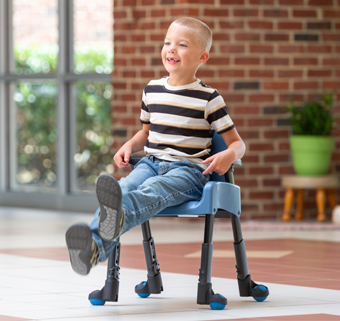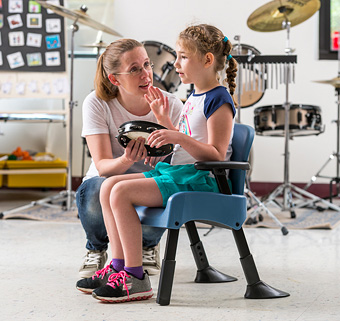ICF: Paving the way to a Special Education Inclusion Classroom: Webinar Transcript
(Return to the webinar ICF: Paving the way to a Special Education Inclusion Classroom)
ICF Slide 1 (0:14)
Welcome. Rifton is happy to introduce you to Sue Cecere in Maryland, who will be hosting this educational Webinar about applying the International Classification of Function in school-based practice.
ICF Slide 2 (0:17)
Sue Cecere is an active member of the Pediatric Section of the American Physical Therapy Association. She is also a certified MOVE International Trainer, and the PT instructional specialist for Prince George’s County in Maryland. It’s an honor for Rifton to share her expertise.
ICF Slide 3 (0:17)
OK, sit up and listen. This is great material. In the next 10 minutes, you’ll learn about the school-based therapist’s role, the relevance of the ICF in the school setting, an overview of ICF framework and its application. Let’s let Sue start right in.
ICF Slide 4 (0:33)
School physical therapists’ role is to support students with disabilities to benefit from their specialized instruction and to optimize function as may be required, to participate in the General Ed Curriculum. IDEA 2004 speaks to participation- which, as therapists, is our ultimate goal for our students. How well a child with a disability participates in his/her daily routines is truly paramount to their health and their well-being.
ICF Slide 5 (0:13)
So regardless of a student’s age, diagnosis or severity of disability, our goal as physical therapists (and especially in school) is to enhance their motor abilities so they can be active participants.
ICF Slide 6 (0:35)
School PTs lend their unique expertise’s to the IEP team through the process of appropriate assessment, environmentally referenced assessment, establishing educational need, applying their unique expertise, using evidence-based decision making and ethics in their decision making. You can read more about School PT under IDEA at the APTA Pediatric Section web site. You can also join the School SIG for free if you are a member of the APTA and the Section. There are just great resources there.
ICF Slide 7 (0:59)
In June of 2008 the APTA House of Delegates officially endorsed the World Health Organization’s International Classification of Functioning, Disability, and Health – also known as the ICF. The ICF recognizes the impact of the environment on the person’s functioning. In the ICF framework the emphasis moves away from the notion of an individual being handicapped by his or her medical diagnosis. “Disability and functioning” are generic terms describing the broad concepts of an individual’s function or inability to function. No other place is this more true than in the school system— as the regulations tell us that we are addressing educational disability, not disability as it applies to a medical diagnosis.
ICF Slide 8 (0:37)
The ICF describes rather than classifies individuals according to their functioning. It gives us, as clinicians, a common language that includes positives and negatives in regard to functioning. Health is defined as the intersection of body functions and structures, activities and participation, within important environments in context for the person. What is critical is what a person really wants to do; what is important to them. As it relates to school, what is important to the family and the team.
ICF Slide 9 (0:34)
So what does the ICF mean for my practice as a School PT? I now need to think more about enabling a student; I can’t be hung up on their deficits. I need to incorporate the whole child, the whole student within the activities and routines of their day, and the context in which those activities and routines happen. My outcome as a therapist – the team’s outcome actually – should be defined and measured as a result of the environment where those activities or routines occur and where the student’s participation becomes meaningful.
ICF Slide 10 (0:23)
Our interventions and their effects must be evaluated in those relevant environments. We’ve not done our job if that student’s motor ability only changes in that therapy room or in a clinic. Our interventions really do need to be evaluated in the context in which they are important because that’s what leads to participation of the student.
ICF Slide 11 (1:46)
If you look at the schematic of the ICF you’ll see that body functions and structures, activities and participation replace previously used terms of impairment, disability and handicap. These terms really do allow positive experiences to be described.
Disability is used to indicate problems in body functions and structures, activity limitations and participation restrictions. It looks kind of complex but it’s actually not difficult to understand the basic concepts.
Current research reflects the view that disability results from the interaction of all these components; the interaction between the person and his or her environment, rather than residing within the person; and that the ability to perform activities and participate in life situations is an essential component of health as defined now by the ICF and the APTA.
Within this framework we have to consider all of these as health factors: body functions and structures, the activities and participation, the personal factors of the student and the environmental factors. When you look at the schematic of the framework, you see the bi-directionality of the components. Our intervention, as school therapists, is to mitigate barriers that exist due to the identified factors that impact the student’s ability to access and participate in school. That’s what our role is. It is not to alleviate impairment. We can alleviate some impairment in the context of addressing participation in school activities and routines. We need to identify barriers, it’s critical to our practice.
ICF Slide 12 (0:43)
As far as school therapy, ICF gives us a much broader base for assessment and intervention. We as therapists need to look beyond the level of body and body parts, body functions and structures, and consider a student’s function at the level of the whole person in their whole school day, their complete environment. We need to help facilitate what that student wants to do in personally important contexts, and in contexts that are important to the school team. It’s about the intersection of body functions and structures, activity and participation demands, and adding in personal and environmental factors which don’t include the health condition.
ICF Slide 13 (0:33)
So what’s the bottom line? The ICF emphasizes overall health rather than a student, or child or a person’s medical deficits. It gives us a much wider lens in which to look at that student, that person. We now know we need to consider the environment and personal factors as we go through our clinical decision making. I would recommend that you go to the web link and it will give you a complete checklist and details for you to learn a lot more about the ICF.
ICF Slide 14 (0:53)
If you become aware of these relationships as they relate to your goals, your interventions and your outcomes, you will really have a much better opportunity to clarify the active ingredients of your intervention process and what will really lead to successful outcomes. Therapists need to explore all intervention strategies including changes to the environment and task. The IEP process is extremely supportive to this idea. When you go through the process and you look at your present levels, your next step is to provide supplementary aids and services for students which is directly correlated to looking at environmental factors and personal factors.
The ICF is not impairment-driven. To date, much of what we’ve been doing as PTs has been aimed at minimizing impairment or attempting to correct them.
ICF Slide 15 (0:36)
So with the ICF, as therapists we can not make an automatic association between the severity of impairment and the level of function of our students. Constraints in body function and structures not amenable to change, can be overcome with environmental support – thus looking at the IEP: supplementary aids and services. In schools we use adaptive equipment – they become environmental interventions that can address multiple needs. Improved engagement with peers, improved access to materials as well as a support to the achievement of goals and objectives.
ICF Slide 16 (0:33)
The ICF offers other domains that should be considered when evaluating a student. (Think about a student’s motivation and their motivation to move.) And then determining what other influences may be affecting that student. Once these areas are considered, then as PTs we have the opportunity to target interventions and involve others who might be able to provide support for the student from a very different perspective. Such as a psychologist, an OT, or speech-language pathologist. This way we can be guaranteed that all the student needs are met.
ICF Slide 17 (0:27)
When we utilize the ICF, we can recognize that impacting a physical impairment may not change the level of function – but addressing other areas such as the environment or a student’s personal factors can. In schools we have to think about instructional supports, program modification, social behavior support, physical/environmental supports and supports for school personnel as interventions to mitigate barriers and to facilitate student performance.
ICF Slide 18 (1:06)
With the ICF functional limitations are defined as restrictions in performance. Our role as school PTs is to minimize or correct these functional limitations so our kids can access and participate in their school community. Appropriate adaptive equipment in the context of school-based practice is a key ingredient to this. In school practice IDEA challenges us to look at access and participation in General Ed Curriculum and the least-restrictive environment. And in that case, maximize student performance despite their physical impairments. The ICF focuses on the positive. It can denote small changes which is just so important to our very special needs populations that we address. It provides us, as therapists and clinicians, a very common language. I urge all school-based therapists to become better versed in the ICF; to learn how to apply it effectively in their school-based practice.
ICF Slide 19 (0:34)
Thank you, Sue. I sure learned a lot from this Webinar and I’m sure our listeners will agree that having an understanding of the ICF can greatly enhance the practice of school-based therapy. Contact Rifton for further information about the products shown in the webinar, and contact Sue Cecere by email for further resources and information about this topic. At this point, you advance to the final slide showing the framework of the ICF once again for your review. Thank you for your attention and participation.




